Digital scammers are the worst, right? They will dupe your sweet Meemaw out of tens of thousands of dollars the first chance they get by making her believe her computer is a ticking time bomb. There are some great YouTube channels that show super-smart people reverse-hacking the scam artists by tapping into their network and watching them squirm live on their own security cameras as they call them by their real names and the authorities are summoned.
This is just one example of the majestic art of using monitoring technology to our advantage.
Now imagine if your product was out-of-stock on HomeDepot.com for weeks, and you didn’t even know it. Or if a third-party seller got away with listing your product for 20 percent below your minimum advertised price (MAP). Or suppose half of your recent reviews on Kroger.com say the product arrived damaged.
These are all things that you’d hope to notice right away, so you could resolve the underlying issues before they blow up into more serious problems. The truth is many ecommerce brands — like your poor Meemaw on her computer — miss the warning signs all the time. Without eyes and ears on the digital shelf, it’s difficult to keep up with what happens there. For most brands, there are simply too many websites, too many product pages, and too many data points to pay attention to.
Digital shelf monitoring is its own majestic art and it’s vital to your brand’s success online. Given the scope of the digital shelf and the challenges involved in monitoring it, most brands don’t know what they should pay attention to or how to do it efficiently. Even with an entire department devoted to digital shelf monitoring, you’re bound to miss key information and valuable opportunities.
In this guide, we’ll walk you through the digital shelf metrics and information sources you should be monitoring, why they matter, plus how to monitor them.
Product page text
Your product page titles, descriptions, and supporting copy have an immense impact on which terms your products rank for and how compelling your pages are to customers. You work hard to optimize this text and ensure your pages provide accurate, persuasive descriptions of what your products are capable of, what problems they solve, and how they help customers reach their goals. But the more sites your products are available on, the easier it is to wind up with variations, outdated copy, and text that simply doesn’t comply with your guidelines.
Sometimes sellers just don’t keep up with your updates, or maybe you forgot to implement the change in the PIM system. Other times sellers make changes themselves. This is problematic for a few reasons:
- Outdated information can mislead customers
- Un-optimized copy may inhibit your rankings and overall performance
- Product page variations weaken your brand integrity by providing different experiences depending on where people encounter your brand
By monitoring your product page text, you help create more consistent experiences with your brand and ensure that the best version of your product page is the only version.
How to monitor product page text
Content compliance can be difficult to track and enforce. It’d be pretty expensive to have employees manually check every seller’s product page. Plus, it’s like playing “spot the differences” with hundreds of photos at once, most of which are actually identical. Human error is unavoidable.
That’s why brands use digital shelf software to monitor product page copy. Tools like Brand Monitor automatically crawl every website your products appear on, comparing the product page titles and descriptions to a master copy. Each seller gets a content compliance score based on how well their page conforms to your brand guidelines.
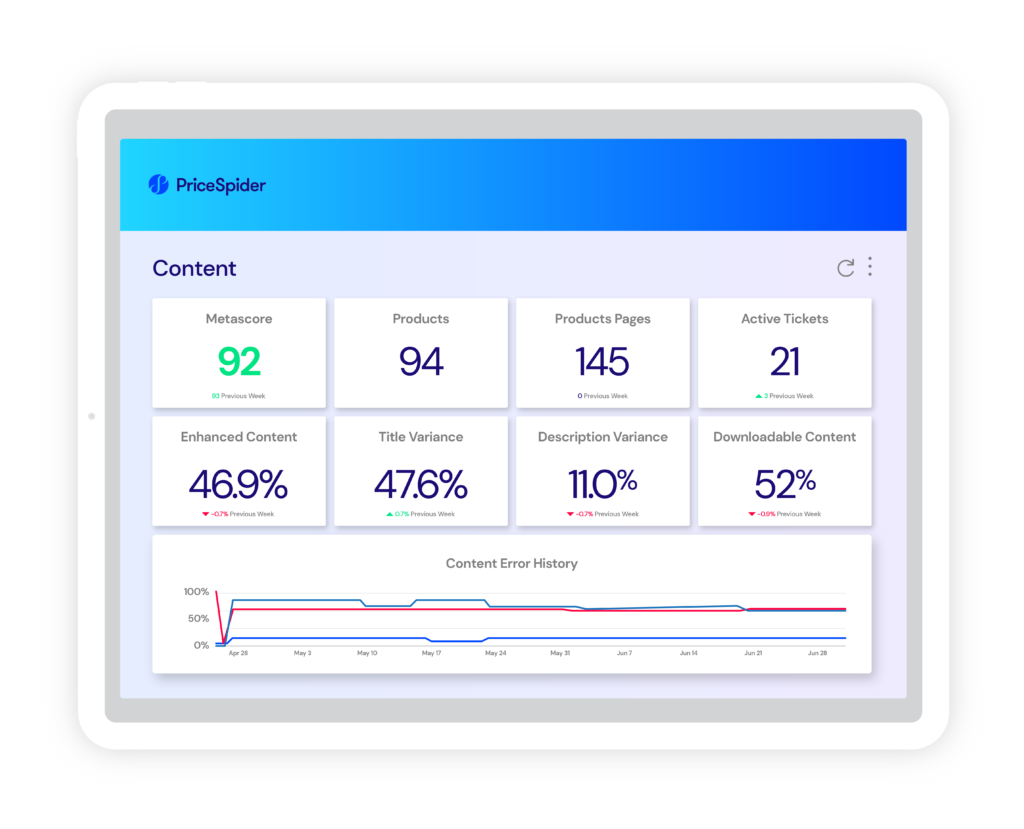
Product images and videos
Visuals are one of the most important features of your product page. Images, videos, and other media help potential customers confirm your product is what they need and fits their style. Depending on your category, how your product looks could even be the most compelling factor in someone’s decision to buy.
Just like product page copy, it’s easy for visual assets to become outdated or for sellers to use their own imagery instead. This presents similar risks to your brand, too, especially if your product’s design has recently changed. Customers could assume your product has capabilities it doesn’t or that it doesn’t have a feature you just added.
Not to mention, video assets are costly to produce. If a seller isn’t using them, they’re wasting your investment in quality asset production.
How to monitor images and videos
Just as with product page copy, it’s extremely inefficient to manually monitor visual assets. It’s also difficult to find software that does it for you. Many digital shelf analytics solutions claim to offer content monitoring, but they’re usually limited to titles and descriptions.
Brand Monitor uses image recognition to identify that all of your prescribed imagery is in use and that it’s in the correct order on the product page. This feeds into the same content compliance score Brand Monitor uses for text assets for a comprehensive look at how well each seller follows your guidelines.
Position in search results
Breaking into the first page of search results — or better yet, the top three positions — can give your products a massive boost in exposure and sales. Customers often only see the first few options a retailer gives them. If you’re on page two or deeper into the retailer’s catalog, most customers won’t know your product exists.
It’s like expecting customers to rummage through the back of the shelf in a brick-and-mortar store or ask an associate if there are other options available in the warehouse. It’s more work to find you, and they’re only going to put in the effort after ruling out every other more prominent option.
Any time your rankings slip or simply aren’t where you want them to be, you need to optimize your product page for the terms that matter most, analyzing top results to determine what they have that you don’t.
But you’ll notice a change in rankings only if you’ve been monitoring your position.
How to monitor product search position
When it comes to monitoring your position in search, the main challenge is deciding which terms to monitor for each product. You want to identify the keywords, phrases, and categories consumers use to find products like yours, but the most popular ones may vary from one retailer to another.
Further, every retailer has its own independent search engine. To identify keywords manually, you’d have to run multiple searches for each product on each website, checking your position each time. Can you imagine attempting to track that over time?
Thankfully, you don’t have to. Brand Monitor can track your position in search results for every keyword that matters to you on every website you sell through. Our Share of Search feature monitors when you’re on the first page or top three for each keyword, as well as whether your position comes from sponsored ads or organic rankings. You can even track this same information for your competitors for insights into where they’re focusing their ad spend.
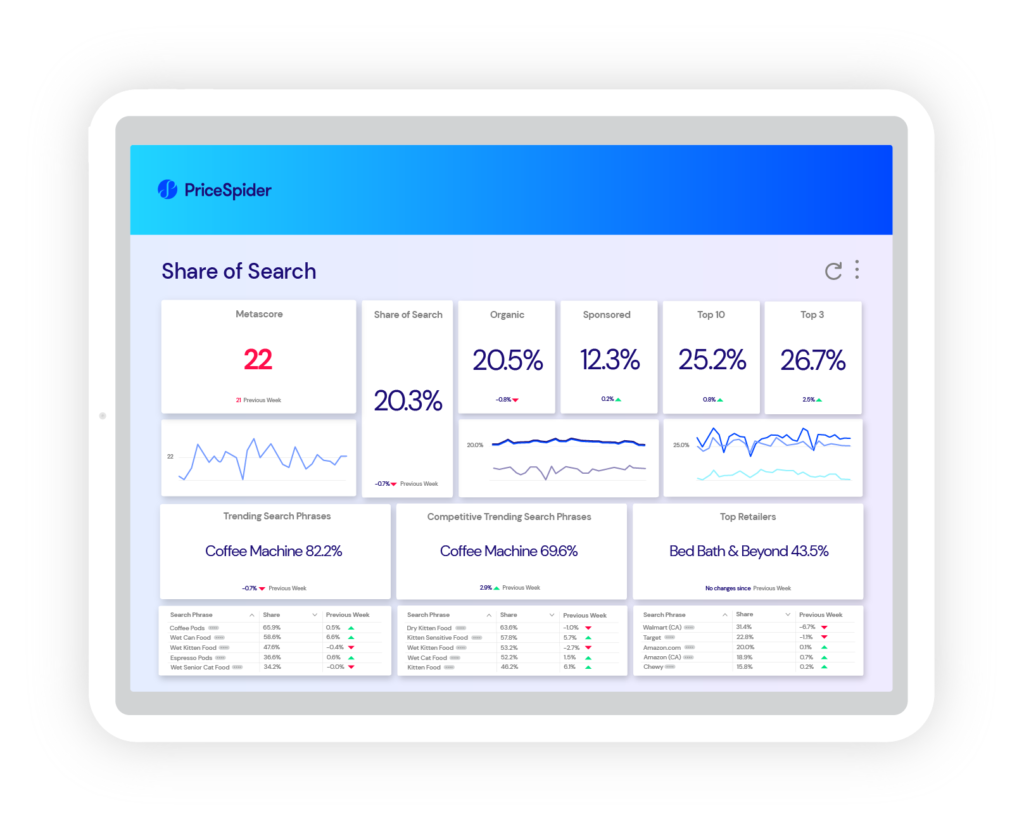
Over time, this aspect of digital shelf monitoring helps you gauge the impact of product page updates, an influx of ratings and reviews, or a competitor who just raced onto the scene. Did that latest change to your title help or hurt your rankings? Do you need to go back to the drawing board, find a middle ground, or borrow from a competitor’s model? Monitoring your position in search helps guide these decisions.
Your products’ stock availability
Let’s say you have 1,000 SKUs in your catalog and 30 sellers. If every seller carried your entire catalog, you’d have 30,000 product pages to monitor. At any given time, some of these product pages will go out of stock.
When a customer wants your product and it’s out of stock, they have three main choices:
- Leave the website and look for it elsewhere
- Buy an alternative product that is available on the website
- Give up
None of these options is a sale for you on this particular page. If you pay to drive traffic to this page, you’re essentially paying to send people to your competitors. Most brands don’t follow their stock availability closely enough to avoid this wasted ad spend. Whether your product is out-of-stock for hours or days, you could wind up paying for thousands of impressions that will never convert.
With savvy digital shelf monitoring, you can fine-tune your ad spend and stop wasting your budget.
How to monitor stock availability
Stock availability changes so frequently that you should only act on real-time data. You want to be confident that you’re not learning a product is out-of-stock (or back in stock) hours after the fact. Obviously, you’re not going to pay people to watch your pages 24/7. Since most digital shelf software pulls this information only periodically, you could wind up acting on outdated data.
Using our proprietary “spidering” technology, Brand Monitor crawls every page your SKU appears on in real time, browsing them just as a person would. The moment your product’s stock status changes, you get a notification.
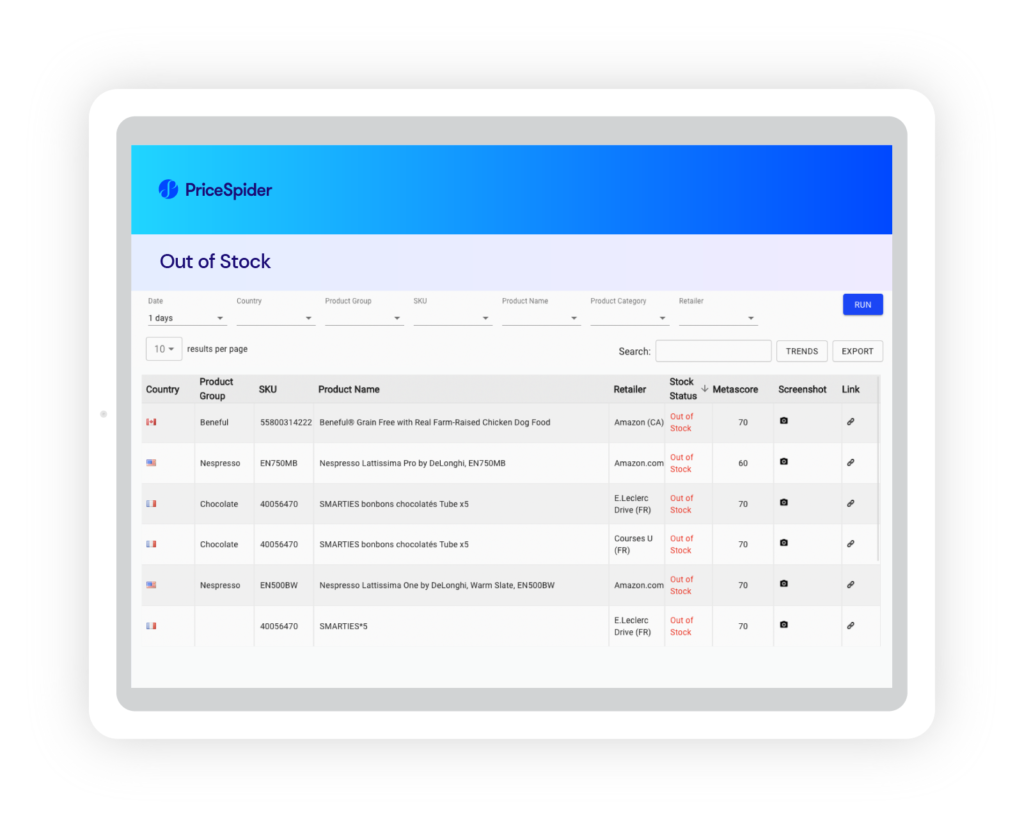
Competitors’ stock availability
It’s equally valuable to monitor the availability of your competitors’ products. Any time their products are out-of-stock, their customers face those same three choices as yours. And just because the item is out of stock doesn’t mean people stop searching for it. If you position your product as the first available substitute, you can steal some of their customers.
This is the best time to advertise on your competitors’ branded keywords. Especially if that competitor has substantial brand recognition or the product is popular.
Advertising on a competitor’s branded keywords isn’t always the best strategy. People who search these terms aren’t looking for any product in your category — they have a specific one in mind. But if that item becomes unavailable, you can effectively say, “I’m sorry you can’t have that right now, but this is just as good.”
How to monitor competitors’ stock status
As with monitoring your own availability, Brand Monitor tracks your competitors’ stock status in real time, empowering you to act quickly and make the most of the moment.
Pricing policy violations
Some sellers don’t care about your brand or their relationship with you. They just want to make a quick buck. And until they experience tangible consequences, they aren’t concerned about violating your pricing policy.
When every seller has roughly the same price, consumers choose where they buy based on who gives them the best experience or perks. In other words, your sellers are forced to compete on service. It’s a win for everyone except the sellers who can’t compete that way. These are usually the same sellers who violate your MAP policy.
At least they’re the ones who do it first.
Monitoring pricing policy violations helps you identify these red flags, such as which sellers have to compete on price in order to win? Who isn’t investing in a long-term relationship with your brand? Who do you need to cut ties with?
How to monitor policy violations
Like stock availability, prices can change quickly. In fact, some sellers use repricing software to temporarily change prices at specific times. In some cases, they may even use it to dodge price monitoring software that pulls pricing data at fixed intervals. That’s how they get away with violating your price without being detected.
With real-time price monitoring, Brand Monitor sees the moment a seller changes their price, alerting you to any violations. If it’s relevant to your policy, Brand Monitor can even check the in-cart price.
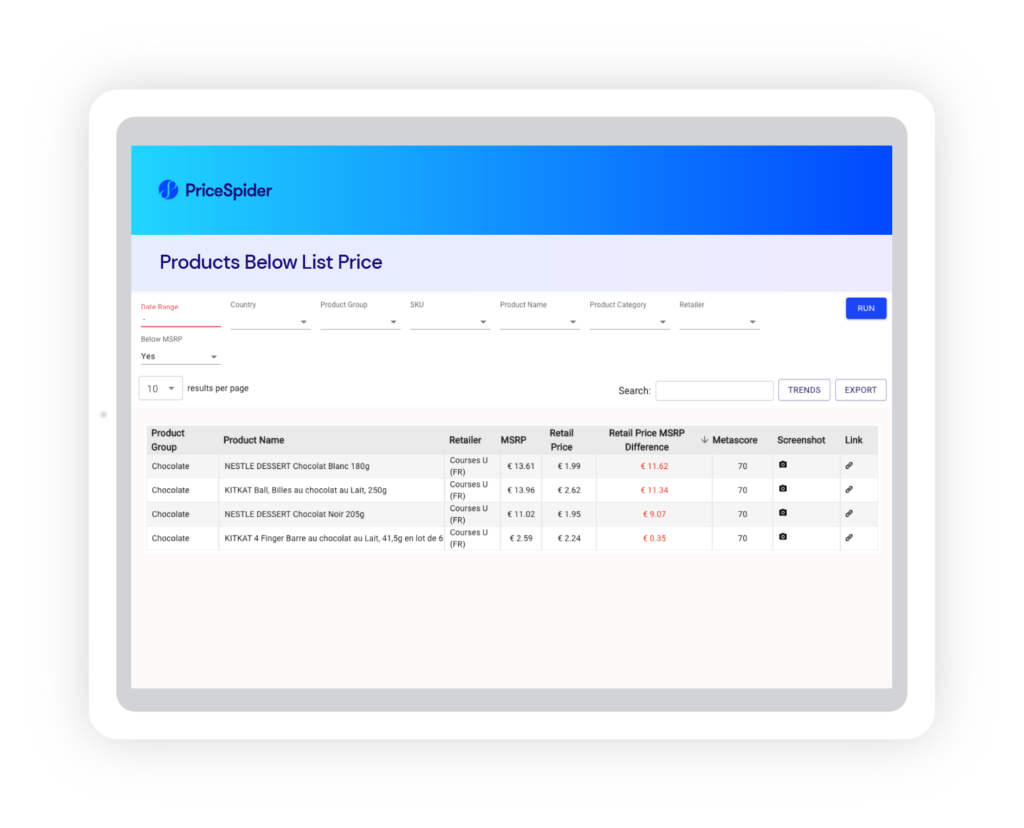
There’s another reason why real-time monitoring is critical. When one seller violates your pricing policy, others have to do the same to compete. That first violation triggers a “race to the bottom.” If you really want to stop future violations, you need to know who moved first. The first violator is the worst offender, and if they persist, you’ll want to create a path out of the relationship.
Customer ratings and reviews
Reviews offer a vital lens into customer sentiments about your products. On its own, one review doesn’t necessarily tell you much. But collectively, they reveal valuable insights into what customers tend to think of your products, what kinds of experiences they have, and how they actually use them.
You also get to see how they would describe your product, which can inform future marketing and product page copy. You might even discover new use cases or benefits you hadn’t thought of.
Similarly, a single rating doesn’t have much impact on your overall rating, but trends are important to watch. You shouldn’t panic about every one-star rating your product receives, but if you get a string of them, and they’re all connected to reviews where people claim to have the same problem, that’s something you need to look into.
Your competitors’ ratings and reviews can be insightful, too. What are their customers complaining about? What do they like about the product? What do they think of the brand? Seeing themes and trends here helps you create more useful comparisons and find new ways to position your product within your category.
How to monitor ratings and reviews
Your ability to recognize trends and themes in ratings and reviews depends on how this information is organized. Sure, you could read every review each week on each product page and scroll through your recent ratings, but wouldn’t it be more useful to filter ratings by date range, view them aggregately across all sites, or simply see the most popular phrases people are using?
Brand Monitor equips you to do just that, giving you more practical ways to explore this crucial feedback.
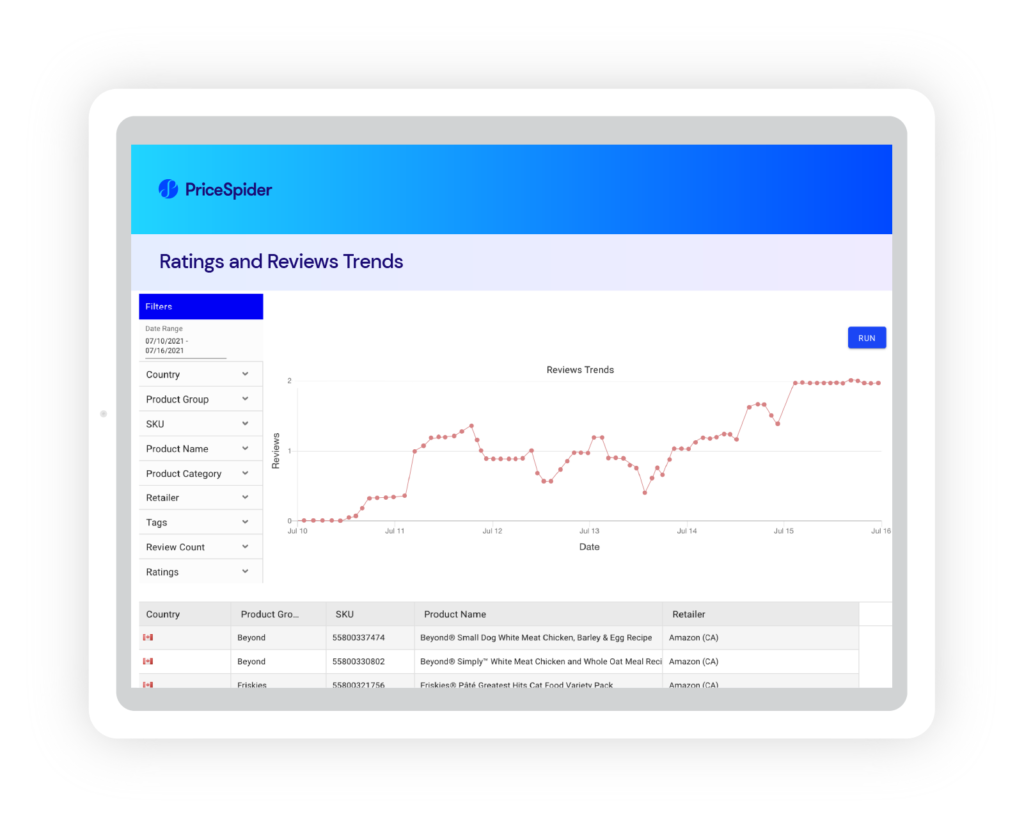
Digital shelf monitoring is absolutely essential
There’s a lot to pay attention to on the digital shelf. With the right tools, you can reap the benefits of comprehensive monitoring without opening thousands of tabs and spending all your time clicking refresh.
Brand Monitor collects and organizes data from the digital shelf, so you always have eyes and ears on the websites and pages you want to monitor.
Interested in seeing what digital shelf monitoring can do for your brand?
Schedule a demo of Brand Monitor today.

